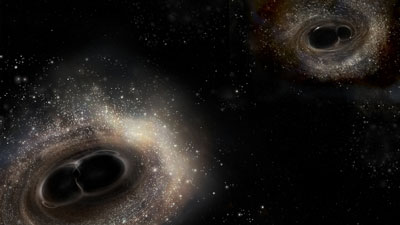
Artist's impression of the two binary black hole systems discovered by aLIGO. Credit: LIGO/A.Simmonet
The Liverpool Telescope (LT) is part of a followup collaboration of telescopes set up to find the electromagnetic (EM) component of gravitational wave events detected by the Advanced Laser Interferometer for Gravitational-wave Observations (aLIGO). The flare of light is not expected to last long, so the "traditional" telescopes that detect only EM radiation must respond rapidly to characterise the source objects.
The LT helped in the search for the EM component for the very first gravitational wave (GW) detection event on 14th September 2015. It did so again for the second event, which although announced by aLIGO last week (see https://www.ligo.caltech.edu/news/ligo20160615), actually occurred on 26th December 2015.
aLIGO alerts of GW events are passed to observatories for followup as little as 30 minutes after detection. They give a search area within which the GW event could have occurred. This search area however is huge, and only facilities with very wide fields of view can efficiently make the initial sweep to look for new transient objects. Once flagged, the LT and other EM facilities can characterise each candidate in the list.
In both events no EM facility found an EM component, but the strategy for instant followup of such alerts is now in place, and has been tested successfully several times.
In a paper entitled "Liverpool Telescope follow-up of candidate electromagnetic counterparts during the first run of Advanced LIGO" Chris Copperwheat et al discusses the LT contribution to the follow-up campaign, and describes in detail the LT's followup strategy and its observations of the candidates GW objects. The paper is currently available from here: https://arxiv.org/abs/1606.04574.


